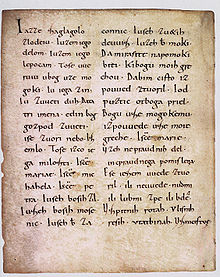This article is about the 10th-century Slovene/Latin theological texts. For the 7th-century Vetus Latina New Testament texts, see Frisingensia Fragmenta.

The Freising manuscripts are the first Latin-script continuous text in a Slavic language and the oldest document in Slovene.
Description and origin
The manuscripts were found bound into a Latin codex (manuscript book). Four parchment leaves and a further quarter of a page have been preserved (i.e., folia 78, 158, 159, 160, and 161, comprising nine pages altogether). They consist of three texts in the oldest Slovene dialect. Linguistic, stylistic and contextual analyses reveal that these are church texts of careful composition and literary form.
The precise date of the origin of the Freising manuscripts cannot be exactly determined; the original text was probably written in the 9th century. In this liturgic and homiletic manuscript, three Slovene records were found and this miscellany was probably an episcopal manual (pontificals). The Freising manuscripts in it were created between 972 and 1039, most likely before 1000. The main support for this dating is the writing, which was used in the centuries after Charlemagne and is named Carolingian minuscule.
During the time of the writing of the two manuscripts (sermons on sin and repentance, a confessional form), Bishop Abraham was active (from 957 to 994) in Freising. It is believed that the manuscripts were written in the Möll Valley in Carinthia. For this reason some linguists (e.g. Jernej Kopitar and Rajko Nahtigal) linked Abraham closely to the origin of the Freising manuscripts and even attributed to him the authorship of one of the texts and suspected that he was of Slovene origin, although this was later disproven.
Modern history
The manuscripts were discovered in Freising, Bavaria. The Slovene name Brižinski spomeniki (literally 'Brižinj Monuments') was coined by the Carinthian Slovene philologist Anton Janežič, who Slovenized the German name Freising to Brižinj in 1854. In 1803, the manuscript came to the Bavarian State Library in Munich and the Freising manuscripts were discovered there in 1807. The texts were translated into modern Slovene in 1854 by Anton Janežič. Before World War II, a facsimile of the Freising manuscripts was published by Silvester Škerl [sl] at Akademska založba (Academic Publisher) in Ljubljana.
Exhibitions
The manuscripts are still kept at the Bavarian State Library in Munich and have left it only twice. In the 1970s, they were exhibited in the Vatican Museums. In May and June 2004, they were exhibited at the National and University Library in Ljubljana.
See also
Notes
- Also Freising folia, Freising fragments, or Freising monuments; German: Freisinger Denkmäler, Latin: Monumenta Frisingensia, Slovene: Brižinski spomeniki or Brižinski rokopisi.
References
- "Collection of Sermons, Treatises, Liturgical Formulae and Canons. Slavic Liturgical Formulae (Freising Monuments)". World Digital Library. Retrieved 2 June 2014.
- ^ Đorđe Sp. Radojičić (1971). Živan Milisavac (ed.). Jugoslovenski književni leksikon [Yugoslav Literary Lexicon] (in Serbo-Croatian). Novi Sad (SAP Vojvodina, SR Serbia): Matica srpska. p. 126.
- Didaktum Language Institute website, Facts about the Slovenian Language
- Grdina, Igor (6 April 2007). "Oris raziskav" [Outline of Research]. In Ogrin, Matija (ed.). Brižinski spomeniki: Monumenta Frisingiensia: elektronska znanstvenokritična izdaja [The Freising Manuscripts: Monumenta Frisingiensa: The Electronic Scientifically Critical Edition] (in Slovenian). Institute of the Slovene Literature and the Slovene language, Scientific Research Centre, Slovenian Academy of Sciences and Arts. §309. ISBN 978-961-6568-33-3.
- Pogačnik, Jože & Franc Zadravec. 1968. Zgodovina slovenskega slovstva: Srednji vek, reformacija in protireformacija, manirizem in barok. Maribor: Obzorja, p. 64.
- Valenčič, Rafko (2002). "Cerkev in kulturne dobrine" [The Church and Cultural Goods] (PDF). Cerkveni Dokumenti (in Slovenian). 97. Družina; Pontifical Commission for the Cultural Goods of the Church: 15. ISBN 961-222-418-8.
- "Vrnitev Brižinskih spomenikov" [The Return of the Freising Monuments]. MMC RTV Slovenija (in Slovenian). RTV Slovenija. 23 June 2004. ISSN 1581-372X.
Literature
- Richards, Ronald O. (2003). The Pannonian Slavic Dialect of the Common Slavic Proto-language: The View from Old Hungarian. Los Angeles: University of California. ISBN 9780974265308.
- Tóth, Imre H. (1996). "The Significance of the Freising Manuscripts (FM) for Slavic Studies in Hungary". Zbornik Brižinski spomeniki. Ljubljana: Slovenska akademija znanosti in umetnosti. pp. 443–448. ISBN 9788671311007.
External links
- Freising manuscripts (Brižinski spomeniki). Scholarly Digital Editions of Slovenian Literature. Scientific Research Centre, Slovenian Academy of Sciences and Arts. Contains a historical overview of the manuscripts, a series of studies and commentaries, a glossary, transcriptions and translations.
- Freisinger Denkmäler (Freising manuscripts), Clm 6426. Bavarian State Library. Presents the manuscripts and contains links to the digitised versions kept by the library.